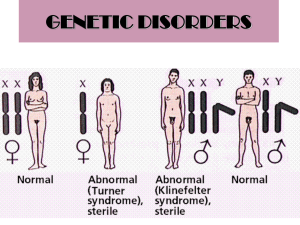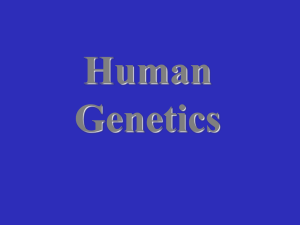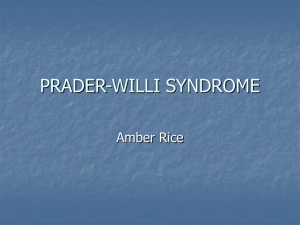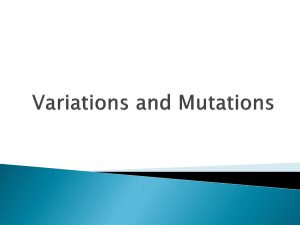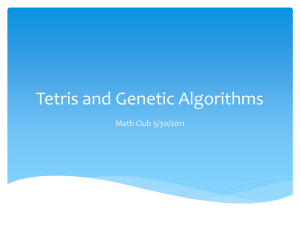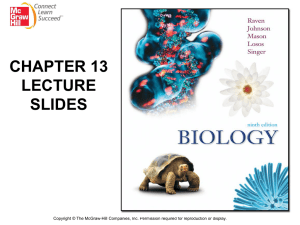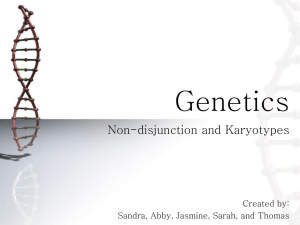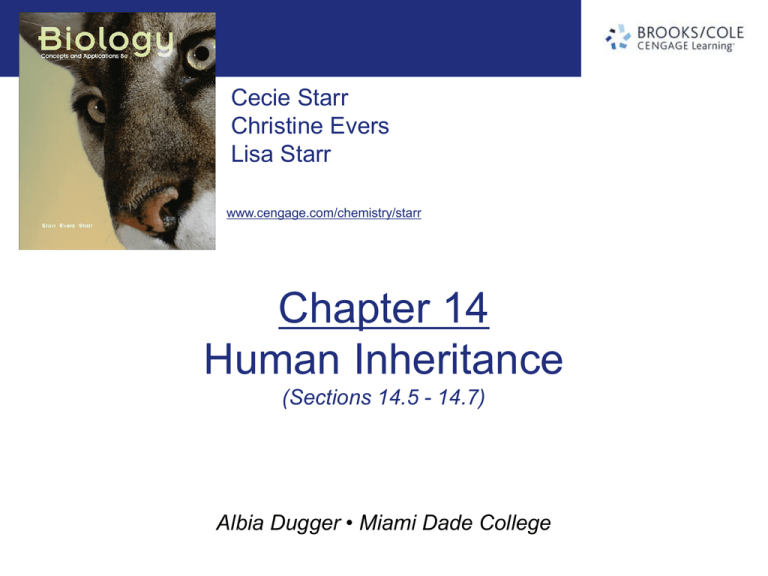
Cecie Starr
Christine Evers
Lisa Starr
www.cengage.com/chemistry/starr
Chapter 14
Human Inheritance
(Sections 14.5 - 14.7)
Albia Dugger • Miami Dade College
14.5 Heritable Changes in
Chromosome Structure
• Major changes in chromosome structure include duplications,
deletions, inversions, and translocations
• Major changes in chromosome structure have been
evolutionarily important
• More frequently, such changes tend to result in genetic
disorders
Duplication
• Duplications occur
during prophase I of
meiosis, when crossing
over occurs unequally
between homologous
chromosomes
• duplication
• Repeated section of a
chromosome
Deletion
• In mammals, deletions
usually cause serious
disorders and are often
lethal
• deletion
• Loss of part of a
chromosome
Inversion
• Inversion may not affect
a carrier’s health if it
doesn’t disrupt a gene,
but it may affect fertility
• inversion
• Structural rearrangement
of a chromosome in
which a part becomes
oriented in the reverse
direction, with no
molecular loss
Duplication and Deletion
A With a duplication, a
section of a chromosome
gets repeated.
B With a deletion, a
section of a
chromosome gets lost.
Fig. 14.9ab, p. 210
Inversion
C With an inversion, a section of a
chromosome gets flipped so it
runs in the opposite orientation.
Fig. 14.9c, p. 210
Translocation
• If a chromosome breaks, the broken part may attach to a
different chromosome, or to a different part of the same one
• Most translocations are reciprocal, or balanced, which means
two chromosomes exchange broken parts
• translocation
• Structural change of a chromosome in which a broken
piece gets reattached in the wrong location
Reciprocal Translocation
• Many reciprocal
translocations have no
adverse effects on
health, but can affect
fertility
Reciprocal Translocation
D With a translocation, a
broken piece of a chromosome
gets reattached in the wrong
place. This example shows a
reciprocal translocation, in
which two chromosomes
exchange chunks.
Fig. 14.9d, p. 210
Some Disorders with
Changes in Chromosome Structure
• Huntington’s disease: expansion mutations (duplications)
• Degeneration of the nervous system
• Cri-du-chat syndrome (deletion)
• Mental impairment; abnormal larynx
• Burkitt’s lymphoma (translocation)
• An aggressive cancer of the immune system
Chromosome Changes in Evolution
• Most major alterations are harmful or lethal in humans
• Even so, many major structural changes have accumulated in
chromosomes of all species over evolutionary time
• Speciation can and does occur by large-scale changes in
chromosomes
Evolution of the Y Chromosome
• X and Y chromosomes were once homologous autosomes in
reptilelike ancestors of mammals
• About 350 mya, a gene on one chromosome mutated –
interfering with crossing over during meiosis – and mutations
began to accumulate separately in the two chromosomes
• Today, the SRY gene (Y chromosome) determines male sex
Evolution of the Y Chromosome
Evolution of the Y Chromosome
(autosome pair)
area that
cannot
cross over
SRY
Ancestral
reptiles
>350 mya
A Before 350
mya, sex was
determined by
temperature, not
by chromosome
differences.
Ancestral
reptiles
350 mya
B The SRY gene
begins to evolve 350
mya. The DNA
sequences of the
chromosomes
diverge as other
mutations
accumulate.
Monotremes
320–240
mya
C By 320–240 mya, the
DNA sequences of the
chromosomes are so
different that the pair
can no longer cross
over in one region. The
Y chromosome begins
to get shorter.
Marsupials
170–130
mya
Monkeys
130–80
mya
Humans
50–30
mya
D Three more times, the pair
stops crossing over in yet
another region. Each time, the
DNA sequences of the
chromosomes diverge, and the Y
chromosome shortens. Today,
the pair crosses over only at a
small region near the ends.
Fig. 14.10, p. 211
Human Evolution
• One human
chromosome matches
two in chimpanzees and
other great apes
• During human
evolution, two
chromosomes fused
end to end and formed
our chromosome 2
Human
Evolution
telomere
sequence
human
chimpanzee
Fig. 14.11, p. 211
ANIMATION: Deletion
To play movie you must be in Slide Show Mode
PC Users: Please wait for content to load, then click to play
Mac Users: CLICK HERE
ANIMATION: Duplication
To play movie you must be in Slide Show Mode
PC Users: Please wait for content to load, then click to play
Mac Users: CLICK HERE
ANIMATION: Inversion
To play movie you must be in Slide Show Mode
PC Users: Please wait for content to load, then click to play
Mac Users: CLICK HERE
Animation: Translocation
To play movie you must be in Slide Show Mode
PC Users: Please wait for content to load, then click to play
Mac Users: CLICK HERE
14.6 Heritable Changes in
the Chromosome Number
• Occasionally, abnormal events occur before or during
meiosis, and new individuals end up with the wrong
chromosome number
• Consequences range from minor to lethal changes in form
and function
Nondisjunction
• Changes in chromosome number are usually caused by
nondisjunction
• Nondisjunction affects chromosome number at fertilization
and causes genetic disorders among resulting offspring
• nondisjunction
• Failure of sister chromatids or homologous chromosomes
to separate during nuclear division
Nondisjunction
Nondisjunction
Metaphase I
Anaphase I
Telophase I
Metaphase II
Anaphase II
Telophase II
Fig. 14.12, p. 212
Nondisjunction
Metaphase I
Anaphase I
Telophase I
Metaphase II
Anaphase II
Telophase II
Stepped Art
Fig. 14.12, p. 212
Aneuploidy
• In aneuploidy, an individual’s cells have too many or too few
copies of a chromosome (result of nondisjunction)
• Most cases of autosomal aneuploidy are lethal in embryos
• aneuploidy
• A chromosome abnormality in which an individual’s cells
carry too many or too few copies of a particular
chromosome
Types of Aneuploidy
• Trisomy:
• A normal gamete (n) fuses with an n+1 gamete
• New individual is trisomic (2n+1), having three of one type
of chromosome and two of every other type
• Monosomy:
• An n-1 gamete fuses with a normal (n) gamete
• New individual is monosomic (2n-1)
Polyploidy
• Polyploid individuals have three or more of each type of
chromosome
• Polyploidy is lethal in humans, but many flowering plants, and
some insects, fishes, and other animals, are polyploid
• polyploid
• Having three or more of each type of chromosome
characteristic of the species
Disorders with
Changes in Chromosome Number
Disorder
Main Symptoms
Down syndrome
Mental impairment; heart defects
Turner syndrome (XO)
Sterility; abnormal ovaries and
sexual traits
Klinefelter syndrome Sterility; mild mental impairment
XXX syndrome
Minimal abnormalities
XYY condition
Mild mental impairment or no effect
Autosomal Change and
Down Syndrome
• The most common aneuploidy, trisomy 21, causes Down
syndrome
• Characteristics include upward-slanting eyes, slightly
flattened facial features, and other symptoms
• Trisomic 21 individuals tend to have moderate to severe
mental impairment and heart problems
Down Syndrome
Down Syndrome
Fig. 14.13a, p. 213
Down Syndrome
Fig. 14.13b, p. 213
Change in Sex Chromosome Number
• A change in the number of sex chromosomes usually results
in some degree of impairment in learning and motor skills
• In individual with trisomy (XXY, XXX, and XYY) these
problems can be subtle and the cause may never be
diagnosed
Female Sex Chromosome
Abnormalities
• Individuals with Turner syndrome have an X chromosome and
no corresponding X or Y chromosome (XO)
• XO individuals are well proportioned but short; their ovaries
do not develop properly, so they do not make enough sex
hormones to become sexually mature
• In XXX syndrome, having extra X chromosomes usually does
not result in physical or medical problems
Male Sex Chromosome Abnormalities
• Males with Klinefelter syndrome (XXY ) tend to be overweight,
tall, and within normal range of intelligence
• They make more estrogen and less testosterone than normal
males, which has feminizing effects
• XYY males tend to be taller than average and have mild
mental impairment, but are otherwise normal
Key Concepts
• Changes in Chromosome Structure and Number
• A chromosome may undergo a large-scale, permanent
change in its structure, or the number of autosomes or sex
chromosomes may change
• In humans, such changes usually result in a genetic
disorder
Animation: Amniocentesis
To play movie you must be in Slide Show Mode
PC Users: Please wait for content to load, then click to play
Mac Users: CLICK HERE
ABC Video: Genetic Testing: Screening
Embryos for Disease
14.7 Genetic Screening
• Prospective parents can estimate probability that a child will
inherit a genetic disorder with genetic screening, in which
pedigrees and genotype are analyzed by a genetic counselor
• Some disorders can be detected early enough to start
countermeasures before symptoms develop
Newborn Screening for PKU
• Most US hospitals now screen newborns for mutations in the
gene for phenylalanine hydroxylase, a defect that can cause
phenylalanine to accumulate to high levels
• The resulting imbalance inhibits protein synthesis in the brain,
which results in severe neurological symptoms characteristic
of phenylketonuria (PKU)
Prenatal Diagnosis
• Prenatal genetic testing of an embryo or fetus can reveal
genetic abnormalities or disorders before birth
• Obstetric sonography
• Fetoscopy
• Amniocentesis
• Chorionic villus sampling (CVS)
• An invasive procedure often carries a risk to the fetus
Imaging a Fetus in the Uterus
• Obstetric sonography
(ultrasound) forms
images of the fetus’s
developing limbs and
internal organs
• Fetoscopy yields
higher-resolution
images
Imaging a Fetus in the Uterus
A An ultrasound image.
Fig. 14.14a, p. 214
Imaging a Fetus in the Uterus
B A fetoscopy image.
Fig. 14.14b, p. 214
Tests for Genetic Disorders
• With amniocentesis,
fetal cells shed into the
fluid inside the amniotic
sac are tested for
genetic disorders
• Chorionic villus
sampling tests cells of
the chorion, which is
part of the placenta
Tests for Genetic Disorders
amniotic sac
placenta
Fig. 14.15, p. 215
Preimplantation Diagnosis
• Clump of cells formed
by three mitotic
divisions after in vitro
fertilization
• One cell can be
removed for genetic
analysis to determine
whether the embryo
carries any genetic
defects
Key Concepts
• Genetic Testing
• Genetic testing provides information about the risk of
passing a harmful allele to one’s offspring
• After conception, various methods of prenatal testing can
reveal a genetic abnormality or disorder in a fetus or
embryo
Shades of Skin (revisited)
• People of Chinese descent carry an allele of the DCT gene
which results in conversion of tyrosine to melanin
• Distribution of SLC24A5 and DCT genes suggests that (1) an
African population was ancestral to both Chinese and
Europeans, and (2) Chinese and European populations
separated before their pigmentation genes mutated and their
skin color changed


